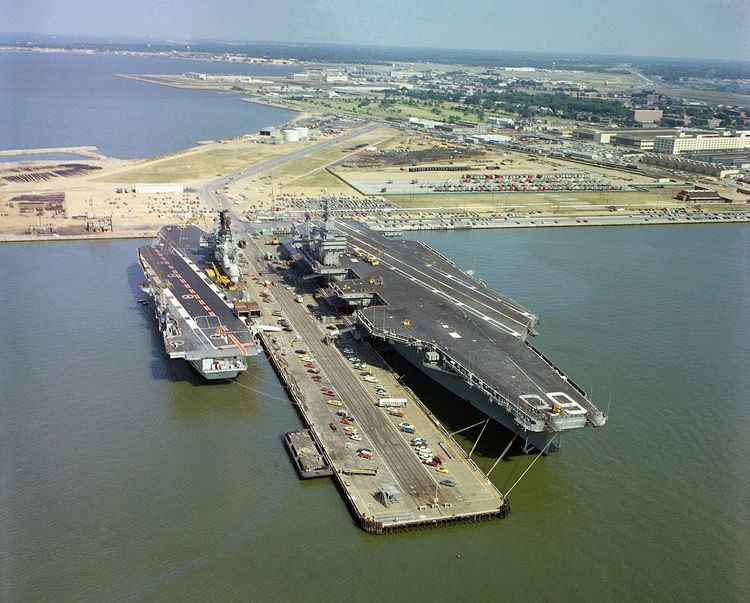 | ||
The capital ships of a navy are its most important warships; they are generally the larger ships when compared to other warships in their respective fleet. A capital ship is generally a leading or a primary ship in a naval fleet.
Contents
William S. Lind, in the book America Can Win (p. 90), defines a capital ship as follows: "These characteristics define a capital ship: if the capital ships are beaten, the navy is beaten. But if the rest of the navy is beaten, the capital ships can still operate. Another characteristic that defines capital ships is that their main opponent is each other."
There is usually no formal criterion for the classification, but it is a useful concept in naval strategy; for example, it permits comparisons between relative naval strengths in a theatre of operations without the need for considering specific details of tonnage or gun diameters.
A notable example of this is the Mahanian doctrine, which was applied in the planning of the defence of Singapore in World War II, where the Royal Navy had to decide the allocation of its battleships and battlecruisers between the Atlantic and Pacific theatres. The war in Europe was primarily a land war; consequently, Germany's surface fleet was small, and the escort ships used in the Battle of the Atlantic were mostly destroyers and destroyer escorts to counter the U-boat threat.
The Mahanian doctrine was also applied by the Imperial Japanese Navy, leading to its preventive move to attack Pearl Harbor and the battleships of the U.S. Pacific Fleet. The naval nature of the Pacific Theater of Operations, more commonly referred to as the Pacific War, necessitated the United States Navy to deploy its battleships and aircraft carriers in the Pacific.
Age of Sail
Before the advent of the all-steel navy in the late 19th century, a capital ship during the Age of Sail was generally understood as a ship that conformed to the Royal Navy's rating system of a ship of the line as being of the first, second, third or fourth rates:
Frigates were ships of the fifth rate; sixth rates comprised small frigates and corvettes. Towards the end of the Napoleonic Wars and into the late 19th century, some larger and more powerful frigates were classified as fourth rates.
Battleship / battlecruiser
The term "capital ship" was first coined in 1909 and formally defined in the limitation treaties of the 1920s and '30s in the Washington Naval Treaty, London Naval Treaty, and Second London Naval Treaty. Dreadnought battleships and battlecruisers were considered to be capital ships. These ships were close to 20,000 tons displacement or heavier, with large caliber guns and heavy armor protection. The treaties specifically excluded aircraft carriers from the definition of "capital ship."
Heavy cruisers, despite being important ships, were not considered capital ships. An exception to the above in World War II was the Deutschland-class cruiser. Though this class was technically similar to a heavy cruiser, albeit with considerably heavier guns, they were regarded by some as capital ships (hence the British label "Pocket battleship") since they were one of the few heavy surface units of the Kriegsmarine. The Alaska-class cruisers, despite being oversized heavy cruisers and not true battleships/battlecruisers, were also considered by some to be capital ships.
During the Cold War, the Soviet Kirov-class had a displacement great enough to rival World War II-era battleships and battlecruisers. The Soviet Navy described it as a heavy nuclear guided-missile cruiser, and in technical design the Kirov is simply a supersized cruiser. However, Western observers referred to the Kirov class as battlecruisers.
Aircraft carrier
Aircraft carriers became recognized as capital ships during World War II. In 1941, the attack on Pearl Harbor sank or damaged all eight of the U.S. Navy's Pacific-fleet battleships. However, American aircraft carriers could still attack the Japanese home islands. In the Battle of the Coral Sea and the Battle of Midway, American and Japanese aircraft carriers concentrated on attacking each other, and the loss of aircraft carriers forced both Japanese fleets to turn back for Japan.
In the 21st century, the aircraft carrier is the last remaining capital ship, with capability defined in decks available and aircraft per deck, rather than in guns and calibers. The United States possesses supremacy, in both categories of aircraft carriers, possessing not only 10 active duty supercarriers each capable of carrying and launching nearly 100 tactical aircraft, but an additional 12 amphibious assault ships as capable (in the "Sea Control Ship" configuration) as the light VSTOL carriers of other nations.
Naming
Some navies reserve specific names for their capital ships, with occasional exceptions. Names reserved for capital ships include chiefs of state (e.g. Bismarck), important places, historically important naval officers or admiralty (e.g. De Ruyter), historical events or objects (e.g. USS Constitution), and traditional names (e.g. HMS Ark Royal).
Currently-commissioned aircraft carriers are currently named after:
The Royal Navy and the United States Navy have given submarines names previously used for battleships, e.g. Vanguard and Ohio. Ballistic missile submarines are important ships that are similar in tonnage to early battleships. However, they are part of a nation's nuclear deterrent force and do not share the sea control mission of traditional capital ships. Ballistic missile submarines are not responsible for attacking each other, and the loss of its submarines does not cripple a navy.
In fiction
The term has been adopted into science fiction literature and culture to describe large spaceships used in military contexts, particularly where other naval terms have also been adopted in similar fashion; for example, sci-fi capital spaceships are often "carriers", that carry small fighters analogous to the way the real world naval equivalent carries fighter aircraft, as well as functioning as "battleships".
